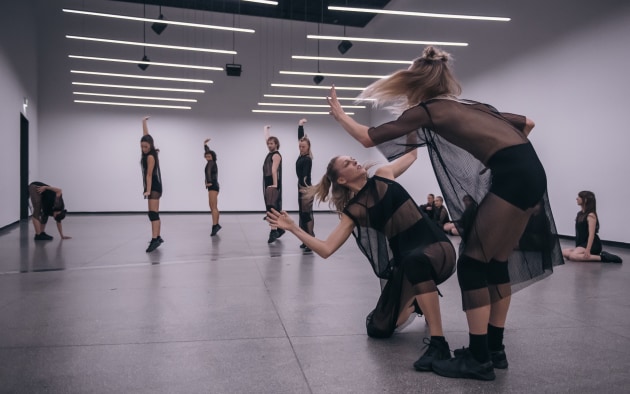REVIEW: FRAME (Part 2)
23 March – 1 April 2023
Various venues
The final week of FRAME – Australia’s new biennial dance festival – gave audiences everything from a three-hour gallery performance to an intimate Japanese cabaret. Breadth and diversity were certainly features of the month-long festival, and while the variety was welcome, the event sometimes felt like a container of ideas without any unifying voice. Arguably a more compact program with a sharper curatorial vision would have helped solidify the new festival’s identity.
NewRetro (Photo by Gregory Lorenzutti)
The most ambitious offering in the final week was NEWRETRO: an immersive curation of excerpts from Lucy Guerin’s 21-year back catalogue, superbly performed by 21 of Melbourne’s most exciting movers in the cavernous halls of the Australian Centre for Contemporary Art. An amoeba of bodies, which dancers join and depart over the course of the three-hour runtime, is the beating heart of the work, forming and dissolving movement ideas from Guerin’s rich and distinct vocabulary. The dancers, dressed in black chiffon and lit by harsh fluorescents, enter and exit the physical archive with the same precision as if handling precious cargo. New bodies discover old material, and generative possibilities are unlocked.
NEWRETRO is a monumental feat of composition. Excerpts are performed in tandem, layered atop one another, isolated and spliced; each encounter sparking new interpretations. Without any significant production elements (which typically feature in Guerin’s works), the material is stripped to its bones, revealing its sophistication and inherent theatricality. As we drift through the four halls of the gallery, curating our own experience of the choreography, we can’t help but be impressed by the depth of Guerin’s oeuvre. Revisiting it all in just three hours is exceptionally rewarding.
Darebin Arts Centre staged a double bill of solos by choreographer and performer Atlanta Eke. In Body of Work, a series of gothic vignettes of moving limbs and objects is filmed, manipulated then played back in real-time across multiple screens. As the body augments, the movement multiplies, and soon the line between original and copy becomes difficult to distinguish. Revisiting this work a decade after its premiere, we are reminded how efficiently Eke manages to distil her choreographic ideas. Scenes are constructed with mathematical exactness, methodically building to reveal a deeply considered comment on the mediated body.

Body of Work (Photo by Gregory Lorenzutti)
Eke’s newest work, QWERTY, is described as a sequel to the 2014 creation, this time engaging more explicitly with the relationship between technology and the body. Sequels are never easy, and whether this one offers anything new is debatable. The same ideas of screen-based augmentation are explored (albeit on a larger scale and using more sophisticated technology) and only the freer form and darker aesthetic are notably different. QWERTY is still compelling (certainly Daniel Jenatsch’s exquisite score is reason enough to see the show), but fans of the original should expect a little less potency.

Somewhere at the beginning by Germaine Acogny and Mikaël Serre (Image credit Hyun Kim)
One of the few international offerings at FRAME was Somewhere at the beginning at Arts House – a powerful solo by the “mother of contemporary African dance” Germaine Acogny under the direction of French-German director Mikaël Serre. Part autobiography, part requiem, the work drifts through layers of memory, personal narrative and political struggle to paint an inherently fractured picture of West African identity and the diasporic experience. Acogny’s movement is both refined and intense; gestural arm phrases carve hard-edged lines before giving way to frenzied chest thumps and slapping of thighs. While the work gives us a gorgeous set design and many striking images, it is the nuance of Acogny’s performance and her command of the stage that is most affecting.

Exposed by Restless Dance Theatre (Image credit Roy Vandervegt)
Also at Arts House was Restless Dance Theatre’s latest work Exposed directed by Michelle Ryan. Exploring themes of vulnerability, the cast of seven dance beneath a giant foil sail, which sometimes appears as an ominous force, and other times glistens like a mysterious beacon. Parallel themes of conflict and support play out in the movement, where colliding bodies and near-miss sprints are set against out-stretched hands and tender embraces. The delicacy of the movement, however, is all but destroyed by the overly sentimental score by Hilary Kleinig and Emily Tulloch, which tries far too hard to manufacture emotions. A clunky lighting design by Geoff Cobham also pulls focus from the choreography. It’s a shame these production elements upstage an otherwise commendable ensemble piece.

IN-VOCATION たまおこし, Yumi Umiumare (Photo by Vikk Shayen)
Rounding out the final week of FRAME was Yumi Umiumare’s IN-VOCATION たまおこし at Dancehouse. Best described as a camp Japanese cabaret for three performers (Umiumare plus visiting artists Kayo Tamura and Kyoko Amara), the work follows the women’s attempt to channel the sacred feminine spirit of Okuni (the creator of Kabuki theatre) through pop songs, 3D video, a tea ceremony and the recounting of personal traumas. It’s a chaotic ride (the work feels sticky-taped together and at risk of unravelling at any moment) and some of the staging and choreography underwhelms. But the performers’ charisma, of which there is ample, somehow manages to save it.
-RHYS RYAN



